A modern crossbreed of chickens, the ISA Brown is low maintenance and personable. It lays plenty of large dark brown eggs. These chickens, also called the Red Star, are adaptable, easy to raise, and relatively healthy.
ISA Brown hens have a low feed-to-output ratio which means they have a high ROI. If you prefer brown eggs, they may be ideal for your homestead. ISA Browns are known worldwide as hardy chickens who lay lots of eggs. This breed is used for about 60% of the brown eggs sold worldwide.
They adapt well to all kinds of living conditions. They are tolerant of heat and also considered to be cold hardy with the proper shelter. In the commercial chicken industry they are housed in battery style cages where their whole lives consist of eating commercial layer pellets and laying eggs.
Homesteaders and backyard chicken owners will find that ISA Brown chickens adapt well to life outside the commercial farm. They reliably lay many large eggs, and they can help you provide eggs for your farm.
History
Created by chicken breeders in the French Institut de Sélection Animale, the ISA Brown was developed in the late 1970s, so it is a fairly new kind of chicken. Breeders wanted to create a chicken for the commercial egg industry.
They crossed Rhode Island Reds, Rhode Island Whites as well as many other breeds. It is also likely that there are some white Leghorns in the mix. The exact breeds used to create the ISA Brown are a closely guarded trade secret.
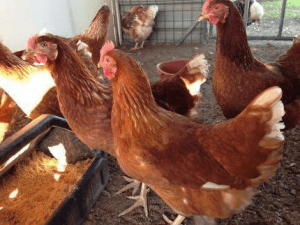
Appearance
The ISA Brown is a rather nondescript looking chicken. Because of the lack of eye-catching features, many people confuse the ISA Brown with other breeds like the Rhode Island Red or the Comet.
While the name tells you that these chickens are brown, the hens can come in a variety of brown shades. They may be chestnut colored, honey colored, or simply red. Their under feathers are often paler. A light buff is common which often peeks through the main color of the plumage.
ISA Brown roosters have much more white on their bodies with patches of black. They also have much larger combs than the hens. ISA Brown roosters have tail feathers that are much longer and more upright than the hens.
ISA Browns are considered a standard sized chicken, although they are generally on the smaller side of that range. Since they are crossbred chickens, there is no breed standard, and they can vary in appearance.
They have yellow skins with single red combs and wattles. The legs of the ISA Brown chicken are clean and yellow with four toes on each foot.
Temperament
Often, chickens that lay prolifically are nervous and not so friendly. However, the ISA Brown is the opposite. Many people who have adopted these chickens from commercial egg facilities are pleasantly surprised at the gentle, friendly, and curious natures of these chickens.
ISA Browns can be initially shy but eventually, if you are patient, they will learn to trust you. They are very docile and often can be affectionate pet chickens. They might jump up into your lap for treats if you give them time. These hens are actually one of the breeds that seem to enjoy being touched and even held, making ISA Brown hens a fabulous choice for children to raise.
ISA Browns are fairly quiet birds. Therefore, they will do pretty well in a subdivision or city lot since they won’t be disruptive to your neighbors. These birds were bred for battery hen conditions. Because of this, if you cannot allow them to free-range, and you have to keep them in a pen, they will be fine.
ISA Brown roosters are overall pretty docile. However, as with all roosters, owners should keep an eye on them since they can be a bit unpredictable at times. Roosters can be a bit more aggressive when they are going through puberty around the ages of 5 – 7 months. If you are considering raising roosters, be sure you will have a minimum of 10 hens per rooster.
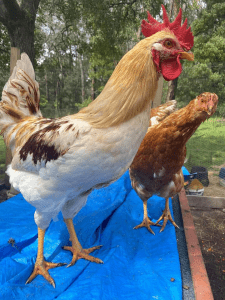
ISA Brown Hens
A medium-sized hen with a slight dip in her back, the ISA Brown hen has a rectangular body and an upright tail. They have brown feathers with white under feathers.
A full-grown pullet will weigh around 5 pounds. These hens have been bred for heavy egg production, starting to lay around four or five months of age.
Like other breeds that were created for egg production, the urge to brood eggs has been bred out of these hens. If selling as many eggs as possible is part of your homesteading plan, ISA Brown chickens might be a great choice. They will give you lots of brown eggs for as little feed as possible.
Roosters
ISA Brown roosters do not grow that much larger than the hens. They only reach about 6 pounds. You can use them for meat. However, there will not be much meat on their bodies. They might be better used for stewing than for roasting.
The ISA Brown rooster has slightly different coloring than the hens. They have more white on their bodies and more generous tails.
Chicks
Most of the time when you buy unsexed chicks, you have to wait several weeks to figure out which are hens and which are roosters. As the roosters grow, they will develop larger combs and wattles, and they will grow a bit faster than the hens. ISA Browns, however, are different from typical chicks in that they spill the beans on gender as soon as they hatch.
One great bonus about the ISA Brown chicks is that the chicks are sex linked. This means that as soon as the chicks hatch, it is readily obvious which ones are hens and which ones are roosters. This is wonderful when you are buying chicks. You can be 100% certain that the gender of your birds is exactly what you want them to be.
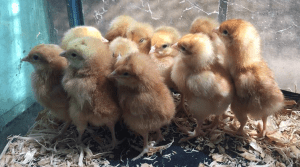
The hen chicks are light brown with white speckles. As the female chicks grow up, they will lose some of their speckles and darken to a deep brown or chestnut. The white feathers will become more a bit prominent.
The male ISA Brown chicks are colored the reverse of what the females are. They are white with brown speckles. As they grow up the roosters keep their color pattern.
Breeding
Because the ISA Brown is a crossbred or hybrid kind of chicken, if you want to get them, you must buy from a commercial breeder. Even if you have a hen and a rooster that are both ISA Browns, they will not breed true.
The offspring of an ISA Brown rooster and hen will be some random crossbreed. You have no way of knowing what traits these chicks will express. It might be a fun project to figure out how the offspring perform, but there are no guarantees when you breed hybrid chickens.
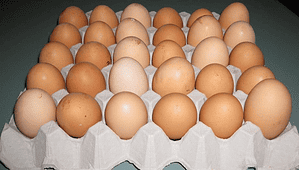
ISA Brown Eggs
ISA Browns might not be the most eye-catching chicken, nor are they the best foragers. However, eggs are where the ISA Brown stands out. These chickens lay eggs like crazy! They are among the best egg laying chickens you can raise.
The hens will lay their first eggs around the age of four to six months and will continue to lay up to 6 eggs a week, totaling up to about 300 eggs per year for the first year and a half to two years.
Unlike other chicken breeds, these hens will continue to lay regularly all year, including in the cold winter months.
After the hens are two years old, they begin to taper off in egg laying. This is why the commercial egg industry often culls their birds at the age of two years. If you live near a commercial egg farm, you may be able to pick up some two-year-old culls.
However, the ISA Brown isn’t completely done at the ripe old age of two. These chickens will still have plenty of egg laying left and can supply eggs for your table even after they are two years old. Even in their “senior years” the ISA Brown will lay a respectable 3 or 4 eggs per week.
The ISA Brown lays large eggs in a medium brown color. In fact, the ISA Brown chicken lays about 60 percent of the brown eggs sold from commercial operations.
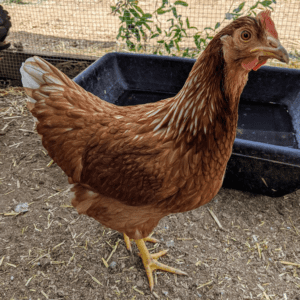
Meat
ISA Browns were bred for only one thing: making lots of eggs. Therefore, they do not make great meat birds. Of course, if you need chicken and this is all you have available, you can dress it out and roast it. Keep in mind that the meat will be scant on the carcass of an ISA Brown chicken. Even the roosters do not dress out into what you might consider a respectable carcass.
ISA Browns definitely demonstrate the idea that you can’t have it all. You can have a bird that lays a ton of eggs, or you can have a bird that makes a good meat carcass, but you won’t find both in the same chicken.
Health Considerations
When comparing best chicken breeds for your backyard, ISA Browns are fairly hardy when they are young. However, as these chickens age, they do have some health considerations. Chickens that were bred with the ideal of becoming “egg machines” do not live long healthy lives.
Usually, since commercial operations cull their laying hens after the age of two years, the breeders are not very concerned with the health problems that are present as the bird gets older. Sadly, these birds will struggle with health issues as they get older.
Prolapses are common in birds like the ISA Brown that are engineered to lay eggs at an extreme pace. A prolapse occurs when part of the hen’s oviduct begins to protrude from her vent. The other chickens may peck at this and that can kill the chicken.
If the prolapse is minor, you may be able to clean the tissue and manually replace it. Keep an eye on your ISA Browns for this common problem. Also, keeping the ISA Brown hen’s weight at a healthy level can prevent a prolapse.
Additionally, to protect against prolapse, do not give the ISA Brown supplemental light in the winter to promote increased egg laying. Allow these birds to enjoy their winter rest.
Kidney problems are also common in the ISA Brown. Again, the egg laying potential of these hens can cost them on the health front, since the mineral balance of their blood can be thrown off easily.
To prevent kidney stones and other kidney problems, feed the ISA Brown a high quality layer pellet and have free choice oyster shell available. Additionally, these ladies need plenty of water for good kidney health.
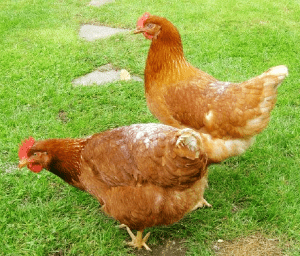
Housing
ISA Browns are content in a variety of conditions. Although they were bred for battery hen conditions, most chicken keepers want to give their hens a much better set up.
While many hens enjoy a free-range situation, the ISA Brown is one chicken that is content in smaller living quarters. They need only about four square feet of coop space per bird. They also only need about 18 inches of perching space. However, for prime health, don’t crowd your birds. It will also reduce stress and competition, promoting a healthier flock overall.
Where to Buy ISA Brown Chickens
As noted above, the ISA Brown hen does not breed true, so you cannot just hatch eggs from your flock of ISA Browns. To get started, you will need to buy chicks from a reputable hatchery that has the correct parent birds. The ISA Brown chicken is a bird with a patented bloodline, so getting good parent birds is important.
In the spring and summer months, it is common for these chicks to be available in farm and feed stores. In addition to the name ISA Brown, look for chicks labeled Red Star, Hubbard Brown, Red Comets or Red Sexlinks. These are all other names for the ISA Brown.
However, many people who want to own an ISA Brown may be able to get them in another way. Commercial egg operations get rid of their hens at the age of 18 months to two years. Sometimes, they allow people to buy the cull chickens for just a few dollars.
Sometimes rescue operations are able to take the birds and find homes for them. Of course, the hens obtained this way are past their prime egg laying years. But, with care, they can last for two or three more years.
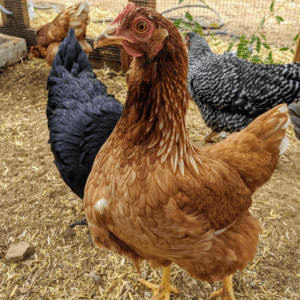
FAQs
How many eggs do ISA Browns lay?
Hens will lay over 300 eggs per year. They will lay at this rate until they are around 2 years old. So for a year and a half, each hen will average laying 450 eggs each.
When do ISA Brown chickens start laying?
ISA hens will start laying when they are between 5 – 6 months old. Be sure to consider diet transitions for females intended as layers. Laying hens that are 18 weeks and older require a layer feed with 14 – 16% protein to prepare them for egg production.
How long do ISA Brown chickens live?
Their lifespan is 3 – 4+ years. They are productive chickens, laying heavily. This takes a toll on their bodies and health.
Where to buy ISA Brown chickens?
You can do a search for ISA Brown chicks near me. Many breeders sell them because they are such reliable layers. In addition, they are fairly cold hardy and somewhat heat tolerant as well. This means you can find them in many areas. Be sure to go to a commercial breeder so you know exactly what you are getting. Because ISA Browns are crossbred, they do not breed true. This means if you have an ISA hen and rooster, it doesn’t guarantee you will hatch true ISA Brown chicks.
ISA Brown Chicken
If part of your homestead business plan is to sell plenty of brown eggs, the ISA Brown chicken might be the best choice for feed conversion and economy. They are friendly, low maintenance, and easy to raise. Choosing the best chicken breed for your farm is important so you can take care of them properly. They resemble the Golden Comet chicken and Rhode Island Reds.

